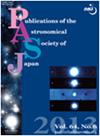宇宙极小尘粒是介观物理学的天然实验室:石墨颗粒的热学和光学特性建模
IF 2.2
4区 物理与天体物理
Q2 ASTRONOMY & ASTROPHYSICS
引用次数: 0
摘要
宇宙中的极小尘粒(VSGs)含有 100 至 10000 个原子,由于每个尘粒中的原子数量有限,因此它们是一个介观系统,具有特殊的热学和光学特性。本文重点研究含有自由电子的石墨 VSGs。本文首次使用 Kubo(1962 年,J. Phys. Soc. Jpn.我们的研究表明,晶粒形状的不规则性使得石墨 VSG 能够吸收或发射亚毫米波长或更长波长的光子;否则,其频率将被限制在几 THz 以上。此外,我们还考虑了表面效应导致的德拜温度降低。VSG 体积极小,因此热能储存有限,尤其是在低温条件下。由于 VSG 能够发射能量小于其内能的光子,这就决定了发射光子的最大频率。我们开发了一种蒙特卡洛模拟代码,用于跟踪尘粒的热历史,其中考虑了环境光子吸收和辐射冷却产生的随机加热。我们将这种方法应用于星际环境,计算星际石墨尘粒的光谱能量分布。结果表明,石墨 VSGs 不仅会发出中红外过量辐射,还会发出亚毫米波段到毫米波段的剩余辐射。本文章由计算机程序翻译,如有差异,请以英文原文为准。
Cosmic very small dust grains as a natural laboratory of mesoscopic physics: Modeling thermal and optical properties of graphite grains
Cosmic very small dust grains (VSGs) contain 100 to 10000 atoms, making them a mesoscopic system with specific thermal and optical characteristics due to the finite number of atoms within each grain. This paper focuses on graphite VSGs which contain free electrons. The energy level statistics devised by Kubo (1962, J. Phys. Soc. Jpn., 17, 975) are used for the first time to understand the thermal properties of free electrons in graphite VSGs. We show that the shape irregularity of the grains allows graphite VSGs to absorb or emit photons at submillimeter wavelengths or longer; otherwise, the frequency is limited to above a few THz. Additionally, we consider the decrease in Debye temperature due to the surface effect. VSGs have an extremely small volume, resulting in limited thermal energy storage, especially at low temperatures. Since a VSG is able to emit a photon with energy smaller than its internal energy, this determines the maximum frequency of the emitted photon. We develop a Monte Carlo simulation code to track the thermal history of a dust grain, considering the stochastic heating from the absorption of ambient photons and radiative cooling. This approach is applied to the interstellar environment to compute the spectral energy distributions from the interstellar graphite dust grains. The results show that graphite VSGs emit not only the mid-infrared excess emission, but also a surplus emission from submillimeter to millimeter wavelengths.
求助全文
通过发布文献求助,成功后即可免费获取论文全文。
去求助
来源期刊

Publications of the Astronomical Society of Japan
地学天文-天文与天体物理
CiteScore
4.10
自引率
13.00%
发文量
98
审稿时长
4-8 weeks
期刊介绍:
Publications of the Astronomical Society of Japan (PASJ) publishes the results of original research in all aspects of astronomy, astrophysics, and fields closely related to them.
 求助内容:
求助内容: 应助结果提醒方式:
应助结果提醒方式:


